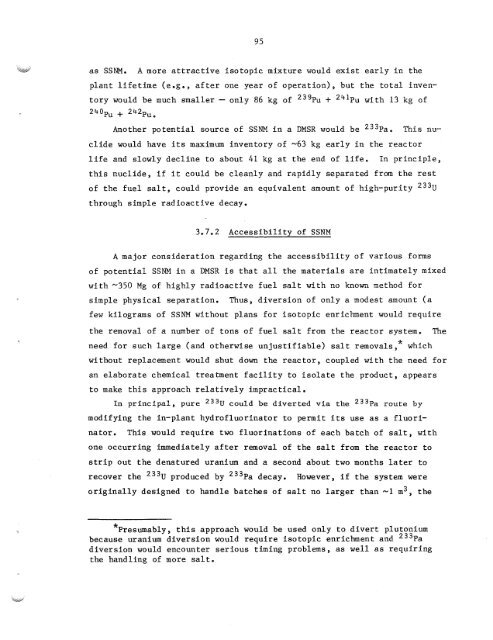ORNL-TM-7207 - the Molten Salt Energy Technologies Web Site
ORNL-TM-7207 - the Molten Salt Energy Technologies Web Site
ORNL-TM-7207 - the Molten Salt Energy Technologies Web Site
Create successful ePaper yourself
Turn your PDF publications into a flip-book with our unique Google optimized e-Paper software.
............. .<br />
. .. .<br />
.=w as SSm, Amore attractive isotopic mixture would exist early in <strong>the</strong><br />
95<br />
plant lifetime (e.g., after one year of operation), but <strong>the</strong> total inven-<br />
tory WQUM be nueh smaller - only 86 kg oi 23%u =+ 24bpu with 13 kg of<br />
24(4Pu + 2%u,<br />
ho<strong>the</strong>r potential source of SSNM in a DMSR would be 233~a. T~FS nu-<br />
clide would have its maximum inventory of -63 kg early in <strong>the</strong> reactor<br />
life and slowly decllbne to about 41 kg at <strong>the</strong> end of life, In principle,<br />
this nuclide, if it could be cleaga~y and rapidly separated from <strong>the</strong> res%:<br />
of <strong>the</strong> fuel salt, could provide an equivalent amount of high-purity 23%<br />
through simple radioactive decay.<br />
3.%,2 Accessibility sf SSMM<br />
A major consideration regarding <strong>the</strong> accessibility of various foms<br />
of potential SSm in a DMSR is that all <strong>the</strong> materials are intimately mixed<br />
with -350 Mg of highly radioactive fuel salt with no known method for<br />
simple physical separation.<br />
nus, diversion of only a modest amount (a<br />
few kilograms of SSNM without plans for isotopic enriebent would require<br />
<strong>the</strong> removal of a number of tons of fuel salt from <strong>the</strong> reactor system. The<br />
need for such large (and o<strong>the</strong>rwise unjustifiable) salt removals, which<br />
without rep~lacenent would shut d ~ m <strong>the</strong> reactor, couple$ with <strong>the</strong> need for<br />
an elaborate chemical treatment facility to isolate <strong>the</strong> produet appears<br />
to make this approach relatively impractical.<br />
In princfpal, pure 233U could be diverted via <strong>the</strong> 233Pa route by<br />
modifying <strong>the</strong> in-plant hydrofluorinator to permit ita use as a fluori-<br />
nator. This would requlre two fluorinations of each batch of salt, with<br />
one occurring immediately after removal of <strong>the</strong> salt from <strong>the</strong> reactor to<br />
strip out <strong>the</strong> denatured uranium and a second about two months later to<br />
recover <strong>the</strong> 233U produced by 233Pa decay. However, i f <strong>the</strong> system were<br />
originally designed to handle batches si salt no larger than -1 m3, <strong>the</strong><br />
~ ~<br />
* Presumably, this approach would be rased only to divert plutonium<br />
~ _ ~ _ _<br />
because uranium diversion wou~d<br />
require isotopic enricbent and 23 +a<br />
diversion would encounter serious timing problems, as well as requiring<br />
<strong>the</strong> handling of more salt.<br />
Jk



![Review of Molten Salt Reactor Physics Calculations [Disc 2]](https://img.yumpu.com/21979492/1/190x247/review-of-molten-salt-reactor-physics-calculations-disc-2.jpg?quality=85)












